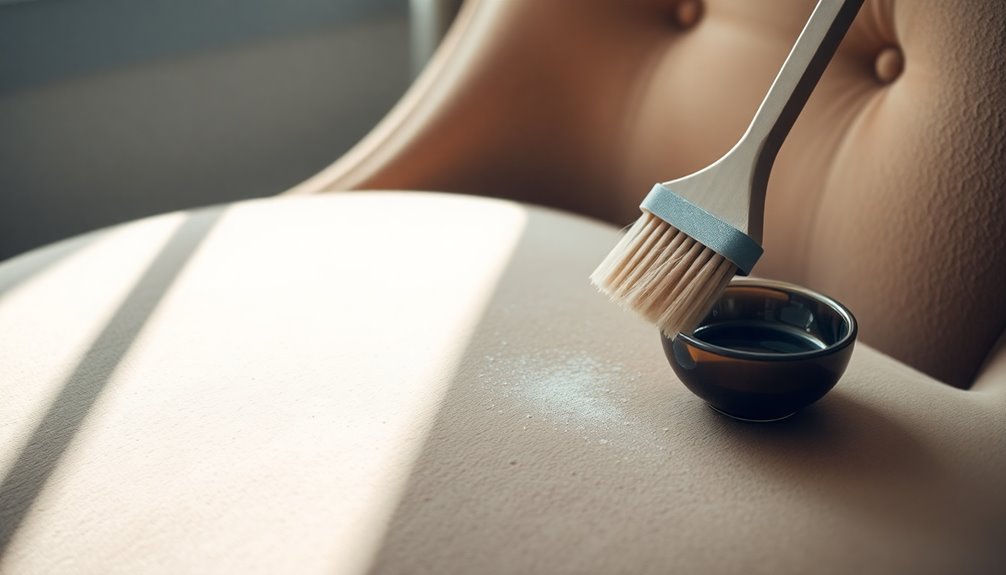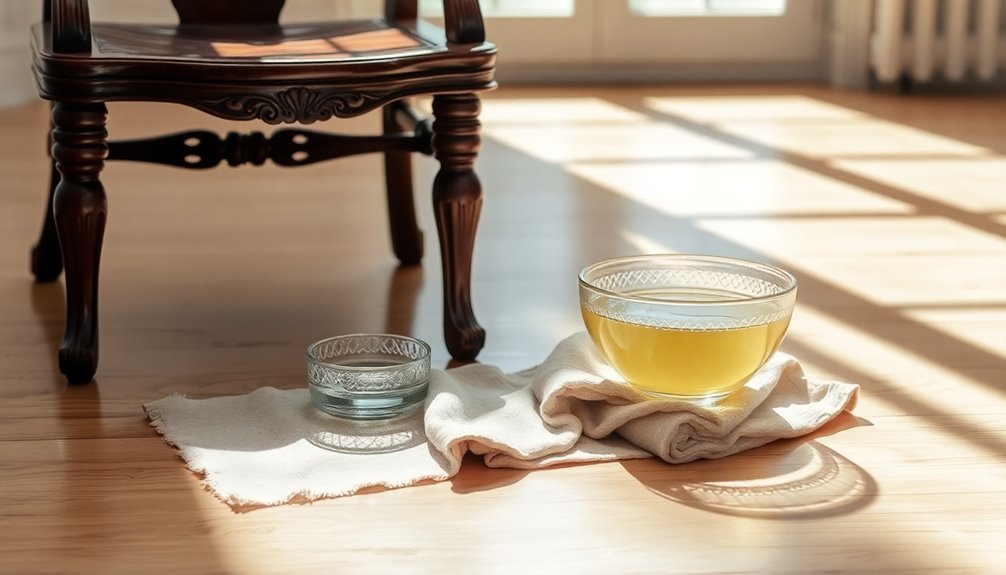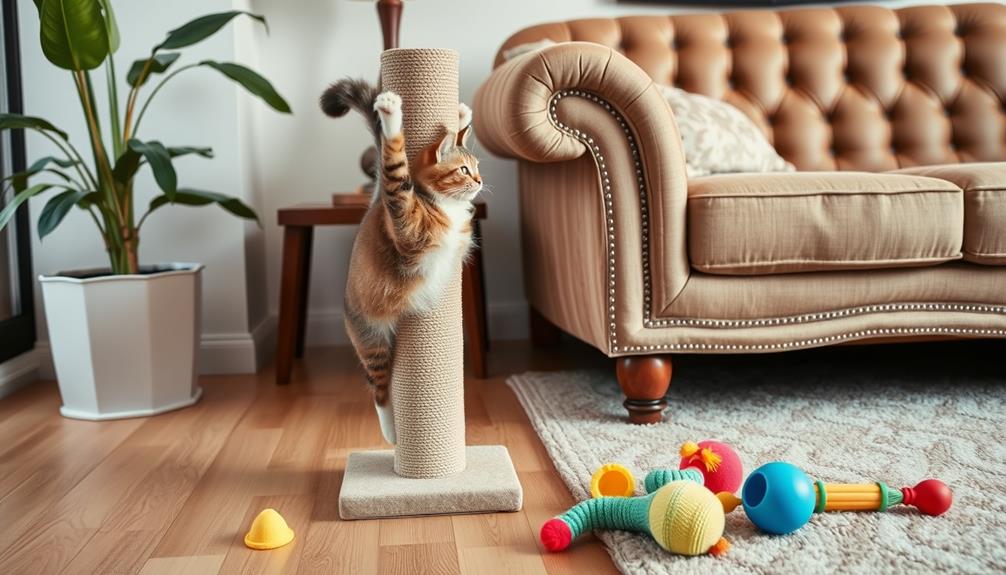To clean your suede furniture, start by checking the care tag for cleaning codes. Regularly vacuum using an upholstery brush to remove dirt. If stains occur, gently blot water-based stains with rubbing alcohol and sprinkle cornstarch on oil-based ones. Use a suede brush to restore the fabric's nap and maintain its texture. For deeper cleaning, consider a low-vapor steam cleaner or professional help, especially for tough stains. Protect your suede with a quality spray, and always remember to treat spills quickly. There's plenty more to explore on maintaining your beautiful suede pieces!
Key Takeaways
- Check the care tag for cleaning codes (W, S, S-W, X) to determine the appropriate cleaning method for your suede furniture.
- Regularly vacuum with an upholstery brush at least once a week to prevent dirt buildup and maintain suede's appearance.
- Treat stains promptly by blotting with rubbing alcohol for water-based stains or cornstarch for oil-based stains to avoid permanent damage.
- Protect suede furniture with a quality protector spray, applying it every few months to shield against moisture and stains.
- Seek professional cleaning for heavy soiling, stubborn stains, or vintage pieces to preserve their appearance and longevity.
Check Cleaning Instructions
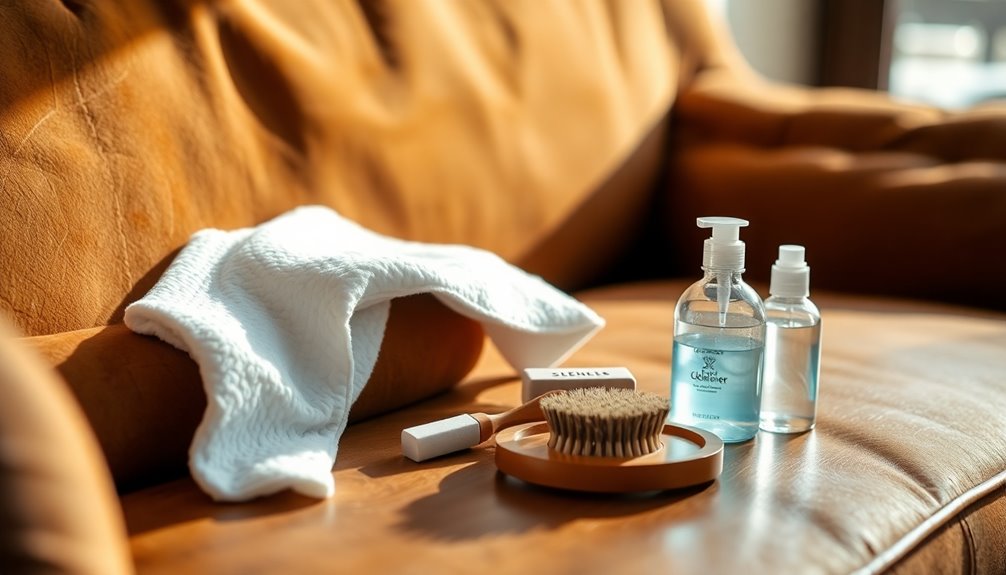
Before you dive into cleaning your suede furniture, it's crucial to check the cleaning instructions. Start by examining the care tag on your furniture for any cleaning codes. You'll typically find labels like W, S, S-W, or X, each guiding your cleaning method.
If you see a W, you're in luck! It means you can safely use a water-based solution. However, if the label reads S, you need to use a special solvent since water can stain the material. For S-W labeled sofas, you have the flexibility to use either a solvent or a water-based cleaner.
An X label indicates that no liquids should be used at all; you'll only be able to vacuum. It's also essential to assess the material composition. Natural suede requires extra care, while faux types like microfiber or ultra suede might have different requirements. Always do a small spot test with whatever cleaning solution you choose. If you're unsure about anything, don't hesitate to consult a professional upholstery cleaner. Following these instructions will help you maintain the beauty and longevity of your suede furniture. Additionally, remember that full cleaning is recommended every six months to maintain quality.
Vacuum Loose Debris
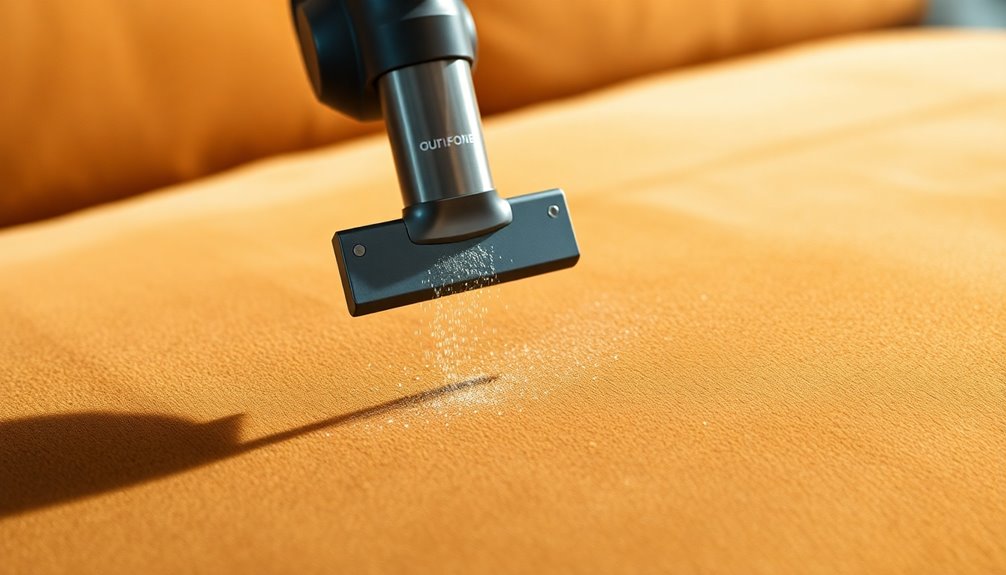
Once you've checked the cleaning instructions, it's time to tackle vacuuming loose debris from your suede furniture. Start by using a vacuum with a soft-bristled or upholstery attachment to prevent scratching the suede. Remove any cushions to access the areas underneath and in the crevices. Vacuum in the direction of the fabric's hairs for the best results, ensuring you reach every corner with a thinner attachment.
Focus on the entire surface of your suede furniture to remove visible dirt, hair, and dust. Pay special attention to spots under and around pillows and cushions, as these areas tend to accumulate debris. Vacuuming regularly, ideally at least once a week, helps prevent dirt from building up and keeps your suede looking its best. Regular maintenance is crucial because suede is softer but more susceptible to dirt and moisture.
Use a handheld vacuum or a larger one with appropriate attachments. A soft-bristled brush attachment is ideal for gentle cleaning, while an upholstery brush attachment can help with detailed areas. Remember, before you begin, check that all attachments are clean and free of debris to avoid transferring dirt back onto your furniture. Regular vacuuming sets the stage for any further cleaning you may need to do.
Use Suede Brush or Stone
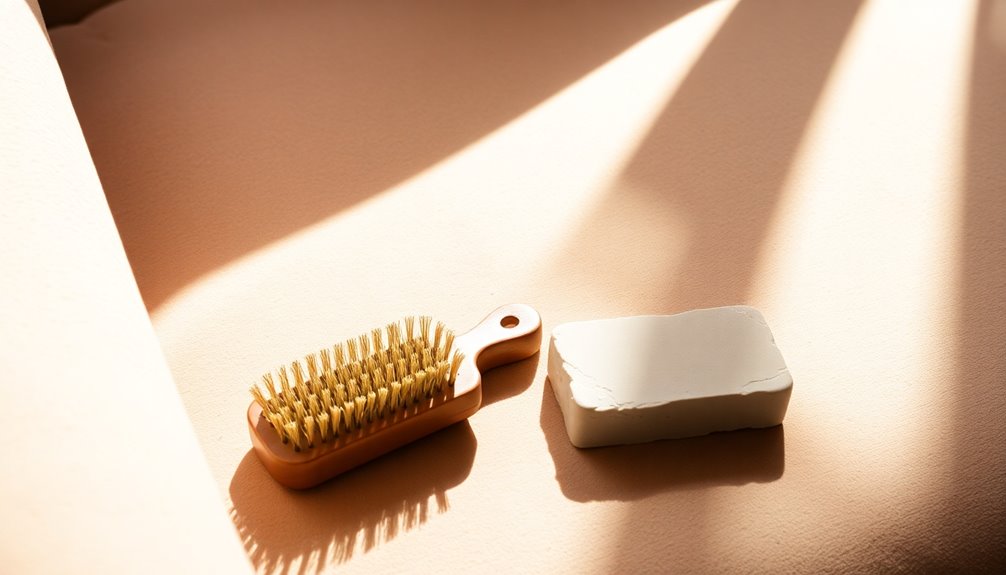
Keeping your suede furniture in top shape requires the right tools, and using a suede brush or stone can make a significant difference. Start with a soft-bristled suede brush, preferably one with natural bristles. This type is less likely to damage the fabric while effectively removing dirt and debris. Brush in the direction of the suede's hairs, applying moderate to firm pressure. Regular brushing helps fluff the suede, enhances its appearance, and prevents stains from settling in.
For more stubborn stains, a suede stone or eraser is your best bet. Gently rub the stone over the stained area, again following the direction of the fibers. Be careful to use moderate pressure and check the stain frequently to avoid over-rubbing. It's best to use the suede stone after you've vacuumed and brushed the furniture to tackle any remaining dirt. Regular maintenance is key to keeping suede in excellent condition, as it prolongs the life of your furniture.
Incorporating these tools into your cleaning routine will not only maintain your suede furniture's texture but also help restore its natural shine and softness. Make sure to brush regularly, especially in high-use areas, to keep everything looking pristine.
Treat Different Stains
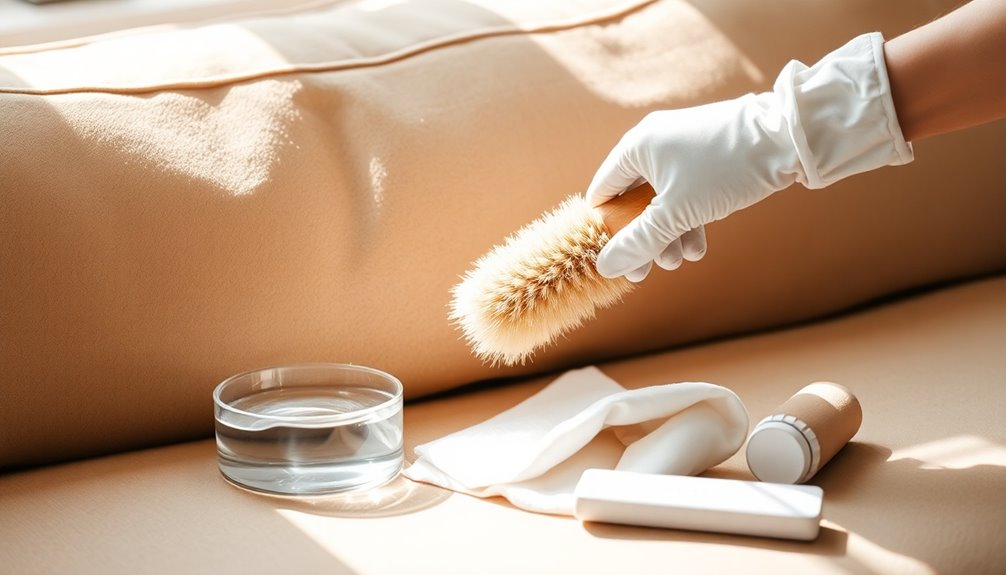
When it comes to treating different stains on suede furniture, prompt action is key to preventing permanent damage. For water-based stains, quickly blot the area with a towel soaked in rubbing alcohol or white vinegar. Use a clean, dry microfiber cloth to further absorb the moisture, lifting the material gently to avoid liquid penetration. If your sofa has a W label, dampen a microfiber cloth with water and rub the stain in a circular motion, but don't soak the suede. Regular maintenance, such as cleaning suede at least once a month, can help prevent stains from setting in.
For oil-based stains, sprinkle cornstarch on the area to absorb the oil, then gently brush it away. Dab the stain with a lint-free cloth or paper towel without rubbing. You can apply ethyl alcohol, ensuring the room is well-ventilated, and repeat the dabbing process until the stain lifts.
For sticky residue or glue, gently scrape it off with a soft-bristled brush. You can also use a suede stain remover or a commercial glue remover. For tougher stains, like wax, apply ice cubes in a plastic bag to harden the material before chipping it off. Always allow the area to dry completely before using the furniture again.
Apply Specific Cleaning Solutions
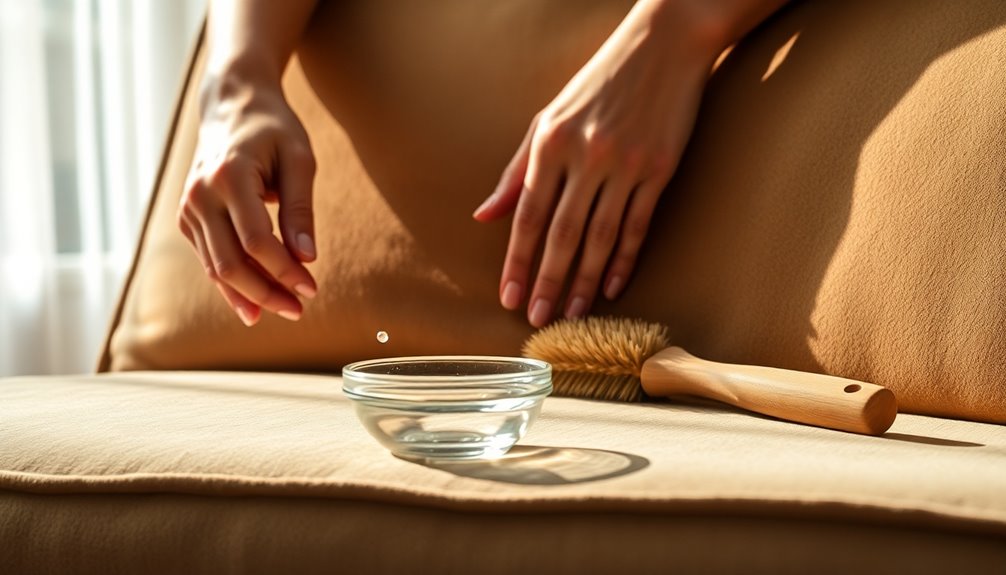
After addressing specific stains, it's time to apply the right cleaning solutions for your suede furniture. If your suede couch has a W or S-W cleaning code, mix warm water with a few drops of mild dish soap. Apply this soapy solution to a brush, not directly to the fabric, to prevent soaking. Adding a teaspoon of white vinegar or baking soda can help neutralize odors and tackle stains. Use a soft-bristled brush or sponge to clean the surface, but remember to spot test on a hidden area first. Professional suede cleaning helps ensure that you use the correct methods and solutions tailored to your fabric type.
For S-labeled suede couches, opt for rubbing alcohol instead of water to avoid damage. Dampen a clean cloth with rubbing alcohol and gently rub the stained area in a circular motion. Don't apply the solvent directly to the suede. If you're using specialist suede cleaning products, follow the manufacturer's instructions and always test on an inconspicuous spot beforehand.
For stubborn oil-based stains, cornstarch works well as a natural absorber. You can also create a paste from baking soda and water for stain removal, or use diluted distilled white vinegar, but again, spot test first to ensure safety.
Dry and Maintain
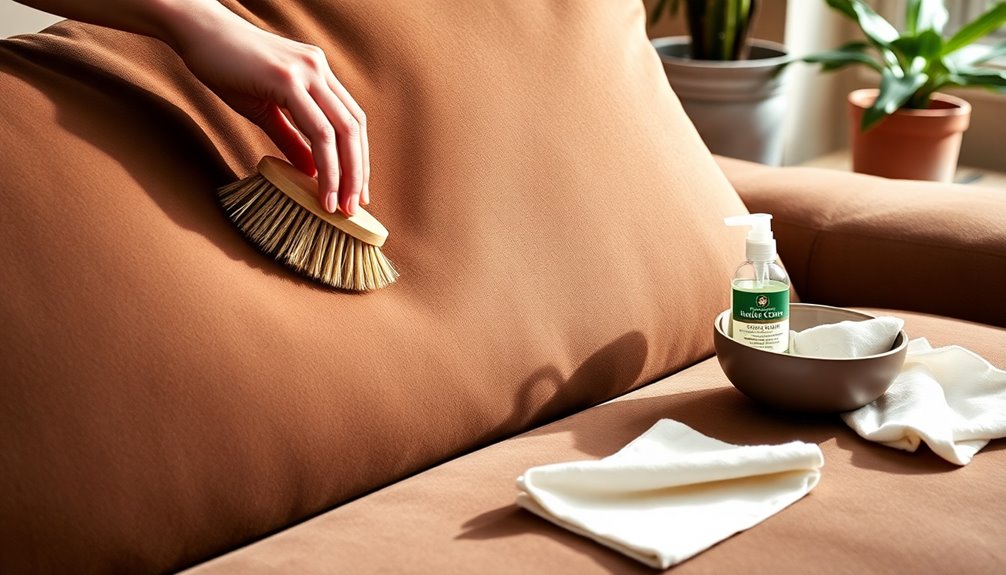
Proper care and maintenance are essential for preserving the beauty of your suede furniture. After cleaning, use a dry cloth to wipe away any excess moisture. Allow the suede to air dry completely to prevent damage; avoid direct sunlight, as it can cause fading. If needed, you can use a fan or open windows to speed up the drying process while ensuring good ventilation to prevent mold growth. Additionally, remember that suede is more susceptible to stains than other leathers, so extra caution during the drying process is important.
Once the suede is dry, gently rub it with a soft scrub brush that has nylon bristles. This will fluff the fibers and restore the nap. Use a suede brush to maintain the original softness and beauty of the material. Brush in long, sweeping motions to align the fibers correctly. Avoid harsh brushes that might damage the suede.
Regularly vacuum your suede furniture using an upholstery brush attachment, moving in alignment with the fabric's grain. This helps maintain its texture and appearance. Aim to vacuum at least once a month to keep dirt and dust at bay. By following these steps, you'll keep your suede furniture looking fresh and inviting for years to come.
Protect Your Suede Furniture
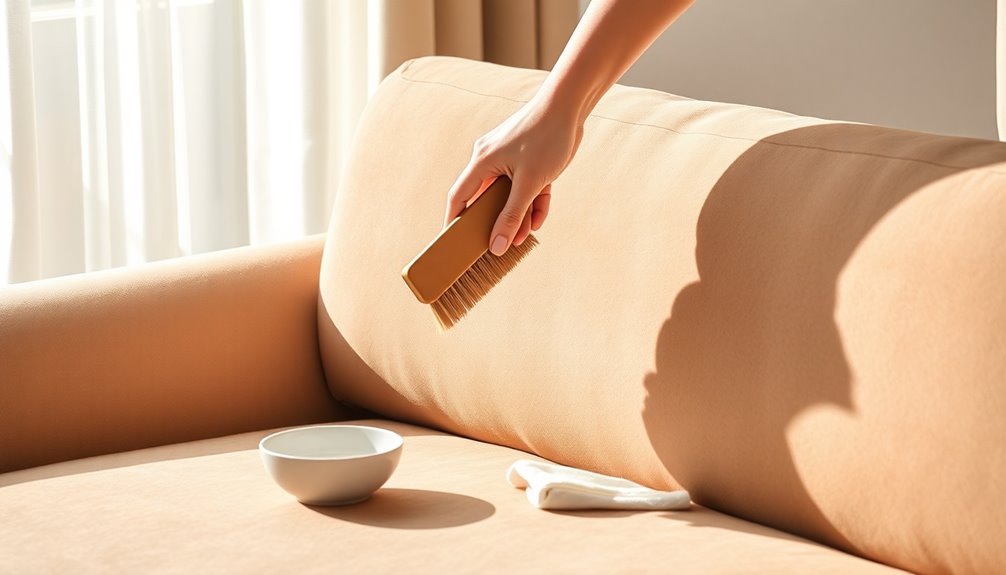
Protecting your suede furniture is crucial for maintaining its elegance and longevity. Start by checking the care tag for cleaning codes, as these will guide you on the proper maintenance. For instance, if your furniture is labeled with a "W," you can use a water-based solution, while "S" means you must use a solvent. "S-W" allows for either method, but "X" requires only vacuuming.
Invest in a quality suede protector spray to shield your furniture from moisture and stains. Make sure the surface is clean and dry before applying the spray evenly, holding the can 6 to 12 inches away. Reapply every few months or after cleaning to maintain protection against dirt, oils, and water-based stains. Since suede is more prone to staining, it's essential to take preventive measures seriously.
Water damage can be detrimental, so if your suede gets wet, blot excess moisture immediately with a clean towel—avoid rubbing it. Let the suede air dry at room temperature, and once dry, use a suede brush to restore its nap.
Finally, store your suede furniture in a cool, dark place, using breathable bags to prevent moisture buildup. This proactive approach will ensure your suede remains beautiful for years to come.
Regular Cleaning Tips
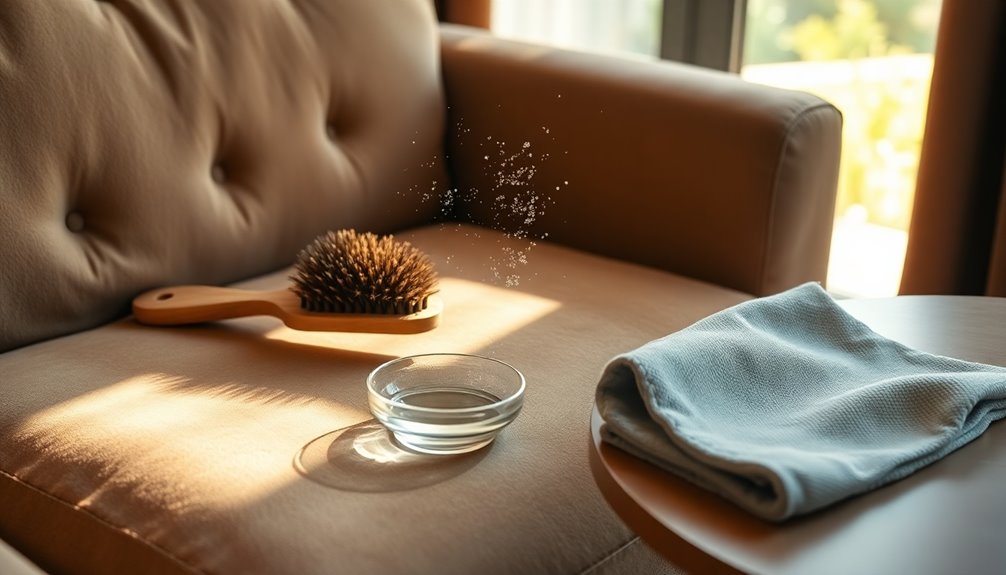
Maintaining the beauty of your suede furniture goes beyond protection; regular cleaning is key to keeping it looking its best. Start by vacuuming your suede weekly to prevent dirt and dust from accumulating. Use an upholstery brush attachment or crevice tool to reach all surfaces, ensuring you capture every bit of debris. Follow this up by brushing the suede with a soft-bristled suede brush, working in the direction of the fabric's hairs to maintain the fibers' nap.
When spills happen, act quickly. Blot the stain with a clean, dry cloth or kitchen roll to soak up moisture. If needed, use a slightly damp cloth but avoid soaking the suede. For stain treatment, apply a solution according to the manufacturer's instructions and dry the area with a hairdryer if necessary. It's important to note that real suede is sensitive to moisture, so extra care should be taken during cleaning.
For surface cleaning, use a suede eraser or cleaning block for natural suede, while checking care tags for microfiber suede instructions. Absorb oil-based stains with cornstarch or baking soda. Finally, remember to perform a deep clean once a year, using a low-vapor steam cleaner or seeking professional help for stubborn stains. Your suede will thank you!
Common Mistakes to Avoid
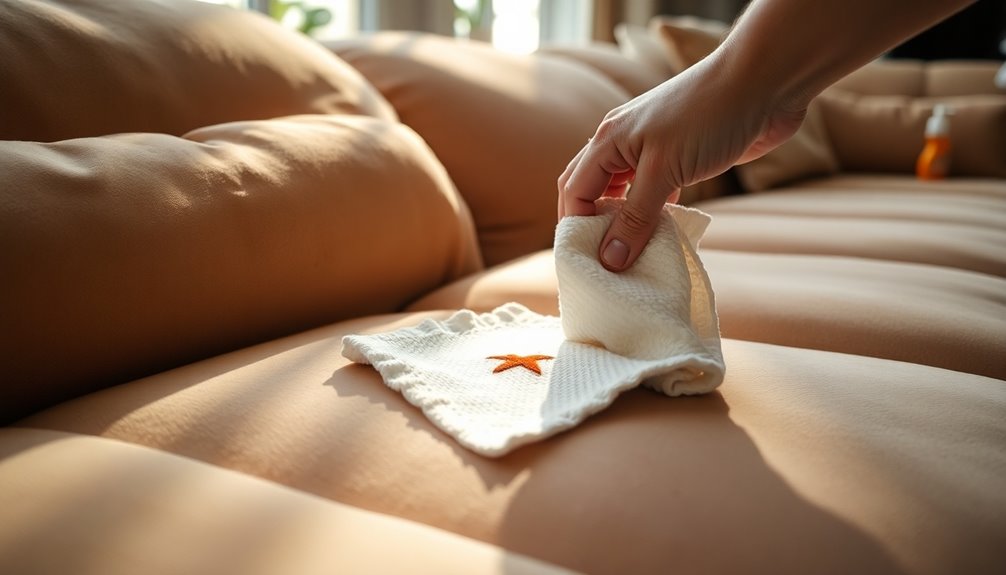
Cleaning suede furniture can be tricky, and making common mistakes can lead to costly damage. One major error is using water-based cleaners. These can cause unsightly water stains and change the fabric's texture. Instead, opt for dry or specialized suede cleaning methods to maintain its appearance.
Another mistake is vigorous scrubbing. This can damage the delicate fabric, spreading stains and matting the nap. Instead, gently blot and dab with a soft cloth or brush to avoid further damage.
Many also make the error of using harsh chemicals or abrasive cleaners, which can cause permanent discoloration and even ruin the texture of the suede. Always select mild, suede-safe cleaning solutions for the best results. Additionally, regular cleaning is essential to prevent dirt and allergens from building up, which can contribute to fabric deterioration over time.
Finally, don't ignore the type of suede or care labels. Misjudging the suede type can lead to incorrect cleaning methods, potentially voiding your furniture's warranty. Always check the care tag for specific cleaning instructions to avoid mishaps. By steering clear of these common mistakes, you can keep your suede furniture looking great for years to come.
When to Call a Professional
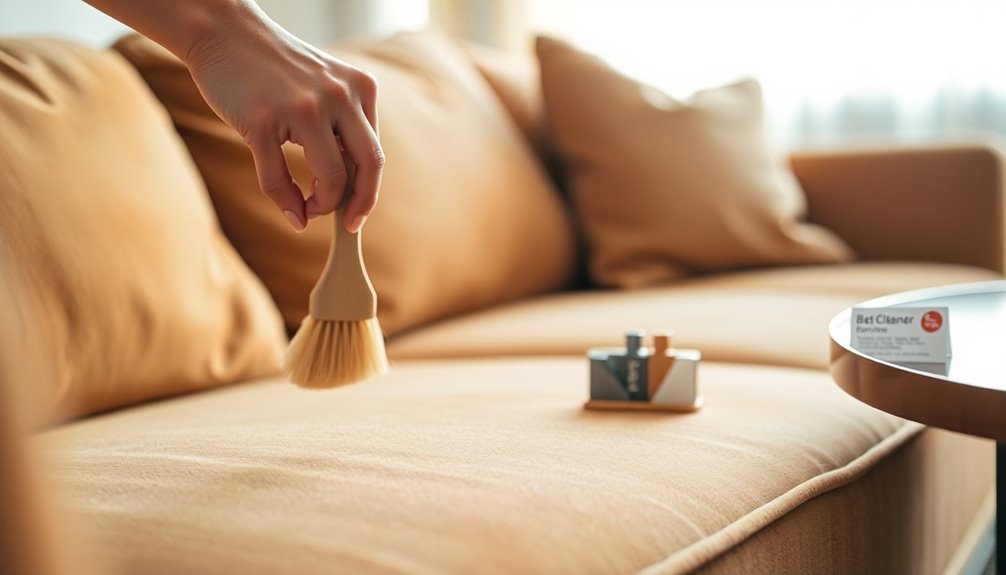
Even with the best care, there are times when suede furniture needs professional attention. If you notice heavy soiling or stubborn stains like wine, mud, or oil that just won't budge, it's time to call in the experts. Furniture marked with an "X" code, indicating no liquids, often requires specialized vacuum cleaning that only professionals can provide.
When DIY methods fail to deliver satisfactory results, you risk causing more damage. If you lack the right tools or cleaning solutions, don't hesitate to seek professional help. Remember, using incorrect methods can lead to irreversible damage, such as color fading or texture changes. Additionally, if your furniture is made from genuine suede, it can be particularly vulnerable to damage from improper cleaning techniques.
Regular maintenance might not be enough for deeply soiled or neglected furniture. If your suede emits persistent odors despite your efforts, a professional cleaning can neutralize these issues effectively. Moreover, if you own high-value or vintage pieces, professional care will help preserve their appearance and longevity.
In essence, when you face complex damage or deep cleaning needs, or if your time and effort aren't yielding results, it's wise to consult a professional who has the expertise to restore your suede furniture to its former glory.
Frequently Asked Questions
Can I Use Regular Furniture Polish on Suede?
You can't use regular furniture polish on suede. It's too harsh and can ruin the soft texture. Instead, it may cause discoloration or change the feel of the material. Suede needs specific care methods, and using regular polish can leave a sticky residue that attracts dirt. Always stick to recommended cleaning solutions for suede to maintain its appearance and longevity. Your suede deserves gentle treatment to keep it looking its best!
How Often Should I Condition Suede Furniture?
You should condition suede furniture every six months to keep it looking its best. This helps maintain the suede's softness and prevents it from drying out or cracking. If your furniture sees heavy use or is exposed to pets and spills, you might want to condition it more frequently, like every three to four months. Always apply a water-based conditioner specifically designed for suede to protect and nourish the fibers effectively.
What Types of Cushions Are Safe for Suede Sofas?
When choosing cushions for your suede sofa, opt for materials that won't damage or stain the suede. Natural fibers like cotton and linen are generally safe, while synthetic options like polyester can work too. Just avoid heavy fabrics or those with rough textures that might snag. Additionally, ensure the cushions have removable covers for easy cleaning. That way, you can maintain your sofa's appearance while enjoying comfort!
Is It Safe to Steam Clean Suede Furniture?
It's not safe to steam clean suede furniture without caution. Steam can shrink and distort the fabric, leading to permanent damage. If you must use a steam cleaner, ensure it's on a low-vapor setting and maintain a safe distance to avoid direct contact. Always follow the manufacturer's guidelines to minimize risks. Remember, regular vacuuming and brushing are often better options for maintaining suede without compromising its texture or appearance.
How Can I Prevent Fading on My Suede Furniture?
To prevent fading on your suede furniture, keep it away from direct sunlight. Position it in shaded areas and use window treatments to block harsh rays. Applying a protective spray can help guard against moisture and stains. Rotate cushions regularly to ensure even exposure, and consider using solar blinds to control light. Lastly, maintain its appearance with a suede brush and conditioner periodically to keep the material looking fresh and vibrant.
Conclusion
Cleaning suede furniture can seem daunting, but with the right approach, it's manageable. By following the cleaning instructions, using the right tools, and treating stains promptly, you can keep your suede looking its best. Don't forget to protect your furniture and establish a regular cleaning routine to prevent build-up. Avoid common mistakes, and if things get overwhelming, don't hesitate to call in a professional. With a little care, your suede furniture will stay beautiful for years to come!
